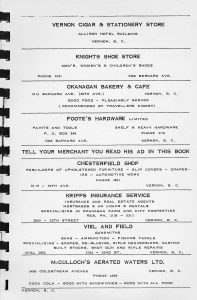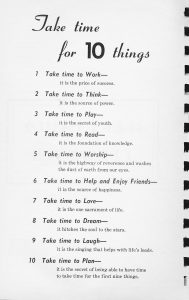Community Cookbook Analysis – “Personal Recipes” – All Saints Anglican Church, Vernon, BC
Old cookbooks are endlessly fascinating. They cause us to remember events and occasions of the past and when we thumb through them we may remember aromas, first tastes, traditions, failures, good and bad times. Community cookbooks provide a window into women’s lives in the past when women pooled their favourite recipes, created cookbooks and sold them to raise money for community clubs and ventures.
I recently analyzed a 64-page coil bound community cookbook from the 1950s that was assembled by The Guilds of All Saints Anglican Church in Vernon, British Columbia, titled Personal Recipes.
There are 88 signed and 4 unsigned contributors of recipes in this book. It contains eight sections of recipes with titles and number of recipes in each section as follows: Relishes, Pickles and Recipes (11 recipes), Soups, Starters, and Beverages (3 recipes); Miscellaneous Meat Substitutes, and Vegetables (5 recipes), Meat, Fish, Poultry (14 recipes); Rolls, Pies and Pastries (17 recipes), Cakes, Cookies (56 recipes), Desserts (12 recipes), and Jelly, Candy, Preserves (eight recipes). In addition to the eight sections of recipes, there are eight pages of information and advice and six pages of advertisements for city merchants.
I analyzed the cookbook with a critical interpretive lens. I completed several readings of the text and did an empirical analysis of the content – the number of contributors, the number of recipes, the kind of ingredients and then considered what was present as well as not present in the text.
I concluded that food preparation was something to be done in the easiest, quickest, most simple way possible in the era when Personal Recipes was written. The recipes suggest that the women who contributed them were not gourmet cooks but rather concerned with providing food for their families in an economic and efficient manner. The women contributed recipes they would recommend to friends or other homemakers – something easy, quick, likely to satisfy or please their family without requiring too much time or labour. The most valued recipes were for baking cakes and cookies. These were often required as treats for family and community events and therefore shared publicly. They were perhaps most revealing of women’s kitchen prowess.
In the era of the 1950s women, working isolated in their home kitchens, were tasked with the responsibilities of food preparation. While the task was not shared, recipes through community cookbooks were. These cookbooks served to sustain an isolation in the kitchen, implied through the desire for simple efficient preparation. Food preparation was not honoured, glorified, revered or communal, but rather fell into the industrial model of efficiency and division of labour.
For the full article, please see the following link: https://bcfoodhistory.ca/food-history-research-papers-3/



